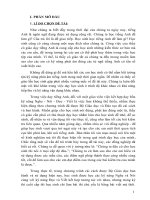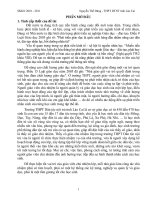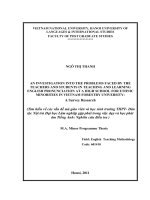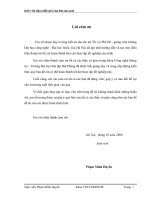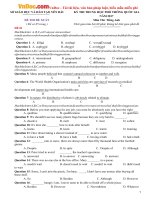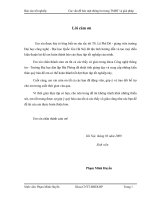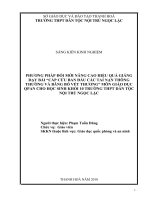Tìm hiểu về các vấn đề mà giáo viên và học sinh trường THPT- Dân tộc Nội trú Đại học Lâm nghiệp gặp phải trong việc dạy và học phát âm Tiếng Anh
Bạn đang xem bản rút gọn của tài liệu. Xem và tải ngay bản đầy đủ của tài liệu tại đây (2.16 MB, 58 trang )
VIETNAM NATIONAL UNIVERSITY, HANOI UNIVERSITY OF
LANGUAGES & INTERNATIONAL STUDIES
FACULTY OF POST GRADUATE STUDIES
*****************
NGÔ THỊ THANH
AN INVESTIGATION INTO THE PROBLEMS FACED BY THE
TEACHERS AND STUDENTS IN TEACHING AND LEARNING
ENGLISH PRONUNCIATION AT A HIGH SCHOOL FOR ETHNIC
MINORITIES IN VIETNAM FORESTRY UNIVERSITY:
A Survey Research
(Tìm hiểu về các vấn đề mà giáo viên và học sinh trường THPT- Dân
tộc Nội trú Đại học Lâm nghiệp gặp phải trong việc dạy và học phát
âm Tiếng Anh: Nghiên cứu điều tra )
M.A. Minor Programme Thesis
Field: English Teaching Methodology
Code: 601410
Hanoi, 2011
VIETNAM NATIONAL UNIVERSITY, HANOI UNIVERSITY OF
LANGUAGES & INTERNATIONAL STUDIES
FACULTY OF POST GRADUATE STUDIES
*****************
NGÔ THỊ THANH
AN INVESTIGATION INTO THE PROBLEMS FACED BY THE
TEACHERS AND STUDENTS IN TEACHING AND LEARNING
ENGLISH PRONUNCIATION AT A HIGH SCHOOL FOR ETHNIC
MINORITIES IN VIETNAM FORESTRY UNIVERSITY:
A Survey Research
(Tìm hiểu về các vấn đề mà giáo viên và học sinh trường THPT- Dân
tộc Nội trú Đại học Lâm nghiệp gặp phải trong việc dạy và học phát
âm Tiếng Anh: Nghiên cứu điều tra )
M.A. Minor Programme Thesis
Field: English Teaching Methodology
Code: 601410
Supervisor: LÂM PHÚC HÂN. M.A.
Hanoi, 2011
iii
TABLE OF CONTENTS
ACKNOWLEDGEMENTS………………………………………………………… i
ABSTRACT………………………………………………………………………… ii
TABLE OF CONTENTS……………………………………………………………. iii
List of abbreviation……………………………………………………………………v
List of table…………………………………………………………………………. vi
PART A: INTRODUCTION …………………………………………………………1
1.1 Rationale of the study …………………………………………………………1
1.2 Aims of the study……………………………………………………………. 2
1.3 Research questions…………………………………………………………… 2
1.4 Scope of the study…………………………………………………………… 2
1.5 Methods of the study………………………………………………………… 3
1.6 Significance of the study…………………………………………………… 3
1.7 Design of the study………………………………………………………… 3
PART B: DEVELOPMENT
CHAPTER ONE: LITERATURE REVIEW …………………………………………5
1.1 English ending sounds………………… …………………………………….5
1.2 Vietnamese ending sounds………… ……………………………………… 7
1.3 Teaching pronunciation……………………………………………………….9
1.3.1 Approaches in teaching pronunciation…………………………… …9
1.3.2 Techniques and activities …………………………………… ……10
1.4. Factors affecting learning pronunciation……………………… ………….12
1.5 Teachers’ and students’ problems in teaching and learning pronunciation 13
CHAPTER TWO: METHODOLOGY OF THE STUDY………………………… 16
2.1 Description of the setting ………………………………………… ……….16
2.1.1 Description of the school …………………………………………… 16
2.1.2 Description of the course …………………………………………… 16
2.2 Subjects…………………………………………………………………… 16
2.3 Research instruments ………………………… ……………………………17
2.4 Data collection procedures ………………………………………………….19
CHAPTER THREE: PRESENTATION OF THE DATA ………………………… 20
3.1 Survey questionnaires …………………………………………………20
3.1.1 Teachers’ and students’ attitudes towards teaching and learning
pronunciation ……………………………………………………………………20
iv
3.1.2 Students’ pronunciation level ………………………………… 20
3.1.3 Pronunciation teaching and learning time… …… ……………21
3.1.4 Teachers and students’ problems in teaching and learning pronunciation
3.1.5 Teachers’ and students’ problems in teaching and learning specific
aspects of pronunciation……….…………………………………………….22
3.1.6 Classroom approaches, techniques and activities used by teachers … 24
3.1.7 Students’ expectations and teachers’ recommendations to teaching and
learning pronuncia……………………………………………………………24
3.2 Classroom observations …………………………………………………… 26
3.2.1 Teaching materials and curriculum ………………… ……………….26
3.2.2 Students’ activities and their mistakes in producing ending sounds… 26
3.2.3 Teachers’ approaches and techniques used in teaching pronunciation 27
4.3 Interviews and discussions………………………………………………… 29
CHAPTER FOUR: DATA ANALYSIS AND DISCUSSION
4.1 Research question 1………………………………………………………….31
4.2 Research question two………………………………………………………. 32
4.2.1 Teachers problems in teaching pronunciation ………………… …….32
4.2.2 Students’ problems learning pronunciation………………………… 34
4.3 Research question 3………………………………………………………… 35
4.3.1 Phonetic training………………………… ……………………………36
4.3.2 Drilling………………… …………………………………………… .36
4.3.3 Listening and imitating……….……………………………………… 36
4.3.4 Reading aloud…… ………………………………………………… 37
4.3.5 Combining of techniques … ………………………………………… 37
PART C: CONCLUSIONS AND RECOMMENDATIONS
1. summary of the findings …………………………………………………… 38
2. limitations and recommendations for further study… ……………………….38
3. Conclusion……….……………………………………………………………39
REREFENCES……………………………………………………………………… 40
APPENDICES ……………………………………………………………………… I
Appendix 1: Survey questionnaire for teachers……………………………… ….I
Appendix 2: Survey questionnaire for students………………………………….IV
Appendix 3: Classroom observation sheet…………………………………… .VII
Appendix 4: Interview questions and transcription…………………………… IX
v
LIST OF ABBREVIATION
1. EMs: Ethnic Minorities……… ………………………………………………ii
2. EMS: Ethnic minority students………………………………………….……ii
3. EmsHS: High school for Ethnic minorities………………………………… ii
4. ESL: English as the second language……………………………………… ii
5. L1: The first language……………………………………………………… ii
6. L2: The second language………………………………………………… ii
7. VFL: Vietnamese as the first language……………………………………….ii
8. VFU: Forestry University of Vietsnam………………………… ………… ii
vi
LIST OF TABLES
Table 1
Teachers’ and students’ attitudes towards teaching and
learning pronunciation
18
Table 2
Teachers’ evaluation about students’ pronunciation level
19
Table 3
Teachers’ and students’ time on pronunciation
19
Table 4
Teachers’ and students’ problems in teaching teaching and
learning pronunciation
20
Table 5
Teachers’ and students’ evaluation about the difficulty in
pronouncing elements of English syllables
20
Table 6
Students’ problems in pronouncing word-final consonants
21
Table 7
Teachers’ activities in pronunciation lessons
21
Table 8
Teachers’ suggestions and Students’ expectations in teaching
and learning pronunciation
22
Table 9
Teachers’ choice of techniques used in teaching
pronunciation
23
1
PART A: INTRODUCTION
1.1 Rationale of the study
Nowadays, with the rapid pace of integration and globalization, English becomes a
golden key to open the door of many fields such as commerce, communication, science and
technology throughout the world. Therefore, to meet the demand of the society, it is very
necessary to teach English in schools at all levels. And the highest target is to get well in
communication. If one wants to get successful in communication, he must be good at
pronunciation: “a threehold level of pronunciation in English such that if a given non-native
speaker's pronunciation falls below this level, he or she will not be able to communicate
orally no matter how good his or her control of English grammar and vocabulary might be”
(Celce-Murcia, 1987:5).
In the field of language teaching, the role of pronunciation has varied widely from
having virtually no role in the grammar-translation method to being the central focus in the
audio-lingual method where emphasis is on the traditional notions of pronunciation, minimal
pairs, drills and short conversations. The growing emphasis on communicative approaches for
the teaching of English has placed higher demands for correct pronunciation. Despite this fact,
at the upper-secondary school level in Vietnam, in language teaching and learning, compared
with vocabulary, grammar and language skills, pronunciation has so far been paid less
attention to. In the official textbooks used for teaching English at high school level, there are a
few exercises for pronunciation practice. To make the matter worse, all important English
exams at schools as well as the entrance exam to universities are always in written form so
most teachers as well as students have little motivation to teach and to learn pronunciation. As
a result, students are often shy and not self-confident to speak in English. And that is the
reason why the effectiveness of teaching pronunciation still remains one of the most extremely
problematic subjects in the field of language teaching.
Coping with this pressing fact, as a language teacher teaching English at EMsHS, I want
to raise these questions: What is the present situation of teaching and learning pronunciation of
English at my school? What are typical problems that teachers and students have in teaching
and learning pronunciation? What are proper methods that can be used to teach pronunciation?
2
What should teachers do to teach pronunciation effectively? And, how should teachers make
students become interested in learning pronunciation? The answers to these questions will help
language teachers improve their students‟ pronunciation as well as help them make progress in
effective communication. For the above reasons, I decided to carry out the study entitled: “An
investigation into problems faced by the teachers and students in teaching and learning
pronunciation at EMsHS in VFU”.
1.2 Aims of the study
The main purpose of this study is to discover the reality of teaching and learning
pronunciation at EMsHS, especially to find out typical problems that teachers and students
often have in pronunciation lessons. The findings of this research will hopefully help students
at high school become well aware of their systematic errors and it can also help the English
teachers make feasible solutions to overcome those problems so as to improve their students‟
pronunciation.
1.3 Research questions
The above aims of the study can be realized by answering the following research
questions:
(1) What is the present situation of teaching and learning pronunciation at EMsHS?
(2) What are typical problems that the teachers and EMS often have in pronunciation lessons?
(3) What teaching techniques can be used to improve teaching pronunciation for EMS at high
school level?
1.4 Scope of the study
As an investigation, this study focuses on the reality of teaching and learning one aspect
of English pronunciation: problems in pronouncing the ending sounds of the 11
th
form EMS at
VFU. The subjects of the study are 50 11
th
form EM students who are familiar with learning
pronunciation for five years. Moreover, ending sounds are taught with major aspects are
consonants in the pronunciation lessons introduced in the official textbook. Scope of the study
is limited to the ending sounds as it is only conducted on the 11
th
form students, other
characteristics of English pronunciation would not be deeply investigated.
3
1.5 Methods of the study
In order to fulfill the tasks mentioned above, both qualitative and quantitative methods
are selected for this case study.
1.6 Instruments of the study
The study involves in the following instruments: survey questionnaires, classroom
observations and interviews. Data is collected through two stages; in the first stage: the survey
questionnaires were delivered to both teachers and students to investigate the reality of
teaching and learning pronunciation at the school. Then, some classroom observations were
taken; and interviews with some English teachers were conducted to get supplementary
information in the second stage. After that, the results obtained from questionnaires,
observations and interviews have been discussed and analyzed with a hope for providing
language teachers with some feasible teaching techniques to work successfully with their
students.
1.7 Significance of the study
This study not only hopes to make contribution to teaching pronunciation at high
school level in Vietnam Forestry University and the result of the study is considered to be
useful teachers and students at the school. Thus, this study will be an interesting reference
material for any high school language teachers in Vietnam, especially for those who are in
favor of improving their EM students' pronunciation. It will also help teachers and students
identify their own problems and self- improve in teaching and learning pronunciation.
1.8 Design of the study
This paper consists of three main parts.
Part A is the INTRODUCTION including the rationales, the aims, the scope, the
research questions, the methods, the instruments and the design of the study. It expresses the
reason why the author decided to choose this investiagion, the methods and the instruments for
the fulfillment of the study.
Part B “ DEVELOPMENT” is the development of the study, which consists of four
chapters.
4
Chapter one is the LITERATURE REVIEW. It starts with theoretical issues on English
pronunciation concepts, some specific features of pronunciation both in English and
Vietnamese (as English ending sounds; Vietnamese ending sounds), as well as approaches,
techniques and activities used in teaching pronunciation. It also covers such factors affecting
learning pronunciation as students‟ motivation, other subjective and objective factors and
students‟ role. Problems in teaching and learning pronunciation are in the last part of the
LITERATURE REVIEW.
Chapter two is the METHODS OF THE STUDY. This chapter starts with the description
of the setting and the participants. It also presents how data was collected through the research
instruments and research procedures.
Chapter three is the PRESENTATION OF THE DATA, in which a summary of the
results and a general narrative description is provided.
Chapter four is the ANALYSIS AND DISCUSSION OF THE DATA, in which
collected data is analysed and findings are explained.
Part C is the CONCLUSION AND RECOMMENDATIONS. This part consists of a
summary of the major findings of the study, some limitations and recommendations for further
study and conclusion lastly presented.
5
PART B: DEVELOPMENT
CHAPTER ONE: LITERATURE REVIEW
This chapter provides readers with the relevant literature of the study by introducing
some key concepts necessary for the best understanding of this research, as well as the review
of previous studies related to the topic. There are some most crucial concepts chosen to be
clarified in this part as: English ending sounds, Vietnamese ending sounds, teaching
pronunciation, factors affecting learning pronunciation and teachers‟ and students‟ problems
in teaching and learning pronunciation.
1.1. English ending sounds
To ESL learners, the term "ending sounds" is familiar as it refers to those
ultimate sounds in a word. More precisely it refers to the consonant sound(s) as the word
can end with one or more consonant sounds (consonant clusters). Thus "ending sounds" in
English pronunciation can be defined as those consonant sounds which appear at the very end
of words. They are also called Codas: "The coda is the final consonant or consonant cluster"
(Barbara A.H and Brian B, 1997).
Yule (2006:47) also wrote “ The basic structure of the kind of syllable found in English
words […] is shown in the accompanying diagram”:
6
According to Cummins (1998), almost every English consonant appears word-finally,
except for /h/, /w/, and /j/. Rachael (2003) also shared this point and said that there can be
up to four consonants in a coda:
If there are no consonants at the end of the word, it has a zero coda.
A single consonant is called the final consonant. Any consonant except h, r, w and j
may be a final coda, for example:
/p/ - rips, keep, sleep
/b/ - rib, nib
/t/ - right, start, cat
/d/ - ride,
/k/ - pick, kick
/g/ - pig, big
/f/ - leaf, chief
/v/ - leave, naïve,
/θ/ - earth, wreath
/ð/ - wreathe, breathe
/s/ - this, miss,
/z/ - these, has, was
/∫/ - crash, splash, smash
/t∫/ - church, teach
/m/ - lamb, room, gloom
/n/ - than, man, happen
/η/ - sing, spring, ceiling
/l/ - pool, file, smile
When there are two or more consonants standing at the end of the word, the terms "pre-final"
and "post-final" consonants are used. Pre-final includes: /m/. /n/, /η/, /l/, /s/. Post-final
includes: /s/, /z/, /t/, /d/, /θ/
Two consonant clusters
- Pre-final m. n, η, l, s followed by a final consonant
- Consonant plus post-final s, z, t, d, θ (e.g: „help, bank, edge, belt, blind, books, six etc)
Three consonant clusters
- Pre-final plus final plus post-final (e.g: helped, banks, bonds, twelfth)
- Final plus post-final plus post final s, z, t, d, θ (e.g: fifths, next, lapsed)
Four consonant clusters
- Most are pre-final plus final plus post final plus post-final e.g: twelfths, prompt so.
Occasionally there is one final and three post final consonants e.g: sixths, texts.
7
It‟s obviously to see that English has a lot of complicated consonant cluster, as listed above,
which combining two, three and even four consonants together in the onset and coda. Thus,
Yule (2006: 48) commented it as “ quite unusual for languages to have consonant clusters of
this type”.
For pronouncing English consonants both at onset or coda “to the extent that phonetics
is part of an exact scientific discipline” (Ladefoged, 2001: 56), nineteen rules were also listed
which might require learners of English rough effort to be adequate (Ladefoged, 2001: 57-60).
Yule (2006: 48), however, suggested that “It is also noticeable in English that large consonant
clusters are frequently reduced in casual conversational speech”. Therefore, it is easily to
understand and see that Vietnamese speaker of English often omit the English ending sounds
or it is pronounced incorrectly by the beginning learners. The following reviews of
Vietnamese ending sounds will explain more precisely about this idea.
1.2. Vietnamese ending sounds
According Ngo (2005), Vietnamese syllable structure is shown as below.
In this table, the tone of each Vietnamese syllable covers the whole syllable and only
the nuclear vowel is compulsory, which is shared by Doan Thien Thuat (Nguyen et al., 2006)
and officially accepted by Vietnamese educators.
In Vietnamese, the number of codas available is just limited to a certain portion.
According to Nguyen (2007), there are only six consonants and two semi-vowels which can
stand in word-final position; however, the important vowels that usually decide the
pronunciation of final consonants are rounded /u, 0, o/ and front /i, e, E</.
8
The following examples are taken from the Vietnamese dictionary (Hoàng, 2000).
i) /m/: in words like
em [Em] ( I, younger sister/ brother), nghiêm [Niem] ( strict)
ii) /n/: in words like
ăn [a<n] ( eat), làm [lam] (do), phiên [fien] (turn)
iii) /N/: there are 3 allophones of this phoneme:
[Nm] : blabialised, proceded by rounded vowels /u, 0, o/
xong [s0Nm] (finish)
súng [suNm] (gun) không [xoNm] ( no, not)
[J]: corresponding to letters "nh", proceded by front vowels /i, e, E</
bệnh [be J ] (sick)
tình [ti J ] (love)
nhanh [ J E<J] (fast)
[N]: other cases
tặng [ta<N] (give gifts)
thiêng [tʰieN] (supernatural)
chuộng [cuoN] (favourite)
iv) /p/: with no air released after pronunciation, in words like:
úp [up] (up-side-down)
Pháp [fap] (France)
tiếp [tiep] (continue)
v)/t/: in English, [t] ending is pronounced both [t] and [?], but in Vietnamese it is always
pronounced shortly and sharply without aspiration such as:
giết [ziet](kill)
ghét [gEt] (hate)
vi)/k/: this sound is produced where the letter "c", "ch" is shown at the final position of a
syllable and it is agreed by many linguists that this phoneme has three allophones which
appeared in a complementary distribution.
9
[kp] this ending sound is bilabialisted if the consonant is preceded by rounded vowels
/u, 0, o/
ngọc [N0<kp] (pearl), cốc [kokp] (cup), nhục [Jukp] (insulted)
[c]: preceded by front vowels /i, e, E</, performed by letters "ch"
nghịch [Nic] (naughty), lệch [lec](askew), sách [SE<c] (book)
[k]: elsewhere
Nhác [Jak] (lazy), bực [bMk] (angry), nhiếc [Jiek] (shout)
vii) /u^/ or /w/: this final semi-vowel only appears in forms of letters "u" or "o" which
follows vowels to make diphthongs or triphthongs, for example:
đau [dau^] (hurt), vào [va:u^] (enter), đều [deu^] (both, alike, equal)
viii) /i^/ or /j/: appears in forms of "i" or "y" and is preceded by vowels to make diphthongs
and triphthongs: tay [tai^] (hand), dài [ja:i^](long) in which [a:] is longer, open and back.
Although the two later sounds are not final consonants, they have certain influence to the
production of errors with final codas. From the list above, it is easy to see that Vietnamese
final consonant sounds just consist of nasal sounds (/m/, /n/, /N/) and three plosive /p/, /t/, /k/;
however, they are voiceless and unaspiratedly. It is plain to see that they are different from
those in English phonetics, which are clearly aspirated. Added to this, the /N/ sound in
Vietnamese seems to be similar to /s/ in English excluded that /N/ is sometimes bilabialized.
Also, it must be noticed that in Vietnamese, there only stand one final consonant at a time;
when in English there can be up to four consonants in onset and coda. The limited codas as
well as non- cluster of Vietnamese make many difficulties for Vietnamese people in properly
pronouncing English language with a wide range of final consonants and clusters.
1.3 Teaching pronunciation
1.3.1 Teaching pronunciation
1.3.1.1 Approaches in teaching pronunciation
In the book “Teaching pronunciation” (Celce-Murcia M., et al., 1996: 2), the authors
point out two general approaches to the teaching of pronunciation in the modern time, namely
intuitive-imitative approach and analytic-linguistic approach.
10
An intuitive-imitative approach depends on “the learners‟ ability to listen to and imitate
the rhythms and sounds of the target language without the intervention of any explicit
information”. This means the teaching of pronunciation depends largely on the teacher‟s
turning on and rewinding a cassette player (or another instrument), and the main activities in
the class are listening and repeating. In this approach, the teacher has no responsibility to
explain how sounds are formed or produced and the learners do their main task of listening
and imitating, and it is expected that learners will gradually gain pronunciation competence.
Meanwhile, an analytic-linguistic approach “utilizes information and tools such as a
phonetic alphabet, articulator descriptions, charts of the vocal apparatus and other aids to
supplement listening, imitation, and production” (Celce-Murcia M., et al., 1996: 2). In this
approach, learners are given explanation as well as training on how to form particular sounds
of the target language. Between these two approaches, there is no scale on whether which one
is better. Hence, teachers are determiners to choose which approach to apply into teaching and
that must be appropriate to the level of learners. However, to do well with these two
approaches, it is a need for both teachers and learners have to fulfill knowledge of articulator
system such as consonants, vowels, stress, and intonation, etc. In this study, the author
considers the use of both approaches to obtain the best effect in teaching and learning
pronunciation.
1.3.1.2 Techniques and activities
Pronunciation is never an end in itself, thus to receive expected result in teaching and
learning pronunciation, teachers have made use of a great deal of techniques. It may be taught
in isolation or in combination with language skills of speaking, listening, reading or writing.
The followings are some common techniques supported by Kelly (2000:16); and Celce (Celce
et al., 1996:8):
Drilling:
One of the main ways in which pronunciation is practiced in the classroom is through
drilling. In its most basic form, drilling simply involves the teacher saying a word or a
structure, and getting class to repeat it.
Listening and imitating
11
The pronunciation of the target language is provided by the teacher or tape recorders,
language labs, etc. students are to listen to a sequence of sounds or sentences and repeat it.
Chaining:
This can be used for sentences which prove difficult for students to pronounce, either
because they are long, or because they include difficult words and sounds
The above mentioned techniques are rather similar; they usually take two forms, which
are either all-class or individual. These two forms are actually the two phase of the same
techniques. Normally, at first, the whole class repeats after certain sound and phrases. After a
certain amount of class-drilling, individual students take turns and pronounce those items
themselves.
Phonetic chaining:
This technique makes use of articulator descriptions, articulator diagrams and a phonetic
alphabet. Learners are provided with basic theoretical knowledge about how sounds are
formed. They are also aided by the teacher to make genuine sound production.
Minimal pair drills:
These relate to Minimal pair drills words which differ from each other only one
phoneme. Normally, students are allowed to listen to the tape and distinguish between the two
sounds. This type of activities is particularly useful to teach sounds which causes difficulties
for learners or sounds that are mismatched.
Contextualized minimal pair:
In this technique, the teacher establishes the setting and present key vocabulary; students
are then trained to respond to a sentence stem with the appropriate meaningful response. When
minimal pair drills seem a bit boring and too theoretical with separated sounds, the
contextualization seems to be more useful because it is more practical.
Tongue Twisters:
This technique rooted from speech correction strategies for native speakers. When other
techniques look serious and sometimes put learners under pressure, tongue twisters provide a
more delighting way to learn pronunciation. Sounds which are difficult to differentiate are put
together to make meaningful sentences.
12
Reading aloud
Students are provided with a passage or scripts and then read aloud, focusing on stress,
timing and intonation. This activity is often done with texts such as poems, rhymes, song
lyrics, etc.
Recording of learners’ production.
This technique can use audio-tape, video-tapes of rehearsed and spontaneous speeches,
free conversations, and role plays. It needs the feedbacks of teachers as well as self-evaluation.
Practice of vowel shifts and stress shifts related by affixation:
Base on rule of generative phonology, used with intermediate or advanced learners. The
teachers point out the rule-based nature of vowel and stress shifts in etymologically related
words to raise awareness; sentences and short texts that contain both number of a pair may be
provide as oral practice material such as: PHOtograph And phoTOgraphy
1.4. Factors affecting learning pronunciation
According to Joane Kenworthy (1987), there are many factors affecting learning
pronunciation, including the native language, the age factor, the amount of exposure, phonetic
ability, attitude and identity.
The native language: it is inevitable that learners‟ native language has a great impact
on their ability of pronouncing English. For example, Vietnamese learners have many
difficulties in pronouncing English consonant clusters because English consonant clusters are
unusuals for them as they do not have this type of consonants in their native language. Also,
some English consonants are pronounced different from Vietnamese such as, in Vietnamese
/p/, /t/, /k/ are uaspirated voiceless plosives but in English they are clearly aspirated (see 1.1,
1.2 in this chapter for futher example).
The age factor: it is often assumed that the younger a person starts learning a foreign
language, the better he is good at pronouncing it and he has a greater chance of having a
native-like accent. This point of view can be seen clearly in Krashen (2004), acquisition and
learning are two ways to develop language competence; however, acquisition and learning are
different processes in which the former is a subconscious process, similar to the way children
acquire their L1 while the later is a conscious process, related to knowing certain rules about a
13
language (grammar, syntax…). It means that younger learners will have more time and chance
to acquire the L2 and they are less influenced by the L1 in comparison with older learners in
pronunciation.
The amount of exposure: people who live in the country where the target language is
spoken and is surrounded by an English-speaking environment may have some advantages
over some who do not. It is a matter of cause that a person lives in an English speaking
environment will do better than whom not.
Phonetic ability: researches have shown that some people naturally have a “better ear”
for a foreign language than others. This point refers to personal properties of an individual.
That means each person owns his or her strong point or weak point in acquiring and learning a
foreign language.
Attitude and identity: results from many studies have shown that learners who have a
positive attitude towards speakers of a foreign language tend to have a more native-like
pronunciation
However, older learners may well speak with an accent because they want to keep their
L1 identity, and the language input for adults is different from that for children because they
rarely get access to the same quantity and quality of language input that children receive in
play setting.
1.5 Teachers’ and students’ problems in teaching and learning pronunciation
Both teachers and students encounter various problems in the process of teaching and
learning pronunciation. These problems do not only arise from the nature of pronunciation
itself, but from various subjective and objective factors. In the light of the previous and current
studies, the followings are some major problems that teachers and learners face in teaching
and learning pronunciation:
The nature of pronunciation
According to Nunan (1992), the problem of acquiring the phonology of a second or a
foreign language presents a formidable challenge to any theory of second language
acquisition. In teaching and learning pronunciation, the biggest problem that most of the
English teachers and students complain come from nature of pronunciation. English
14
pronunciation itself contains so many complicated factors and invisible rules. According to
Ladefoged (2001:57-60), nineteen rules were listed for pronouncing English consonants which
might require learners rough effort to be adequate. For example, rules of pronouncing “s” and
“es” when single verbs are formed for the third person at present simple tense, and they are
applied the same for plural nouns. Or, the rules of pronouncing regular verbs and so on.
In the light of this problem, Doff A. (1988) listed some common problems that
learners often make when they speak English. The first is difficulties in pronouncing sounds
which do not exist in the students‟ own language, e.g: /θ/ does not exist in Vietnamese, so
Vietnamese learners find it difficult to pronounce words with /θ/ as month, 50
th
, bath; or
Vietnamese does not have /b/, /d/, /g/, /f/, /ð/, /z/, /l/… and /s/ at the end of words but in
English, for examples: lab, sod, bag, laugh, love, kiss, buzz, ash, rouge, ball and so on. The
second is the problems with similar sounds that often cause learners‟ confusion such as b vs p,
d vs t, sh vs s as in these pairs of words: pop- bop, crab-cap, brush- bus, doll-toll. The third
is difficulties in pronouncing consonant clusters. Students seem to have a tendency to omit all
final sounds, e.g in these words help, bank, next, texts, months are pronounced respectively by
Vietnamese as /hep/, /bæn/,/ /nek/, /tek/, /mon/.
Class setting
A lot of problems in teaching and learning pronunciation come from class setting such
as classroom size, quality of the teaching staff, teaching and learning equipment. Firstly, a
large class causes difficulty in teaching pronunciation. At high schools in Vietnam, on
average, there are over 50 students per class. With such a high student-teacher ratio, it is
impossible to make sure that the teacher could carry out and control successfully teaching
techniques and activities, and the learner is not able to listen and receive what the teacher is
saying. The quality of teaching staff is also a big problem. Most teachers of English are non-
native speakers, and a few of them can have a native-like pronunciation. So, the language
input that students receive every day is from non-native people. As a result, it is impossible for
students to achieve perfect pronunciation.
Teaching model
15
According to Kelly (2000), in the past, the model of teaching English pronunciation
was “received pronunciation”, the pronunciation of people in the southwest England. Today,
there are a vast number of English languages such as, American English, Australian English,
etc. Thus, teachers must consider to choose what models to be better used in their cases. In
fact, each teacher cannot often produce a “perfect” accent without being affected by his or her
native language. This fact often causes problems for both teachers and students in teaching
and learning pronunciation. Actually, the number of teachers who do not feel confident with
their own voice is not small and students sometimes do not know what input language is
perfect to receive.
Intelligibility
Beside factors from the nature of pronunciation, class setting, etc, teaching and
learning pronunciation involves in its own problem that Kenworthy (1987) calls it as
“intelligibility”. He defines “intelligibility” as “being understood by a listener at a given time
in a given situation”. This means that intelligibility is affected by a number of factors: the
speaker, the listener, the time, and the situation. This also means that teaching and learning
pronunciation depends on many factors, causing many problems for both teachers and
students.
In conclusion, in this chapter, the writer attempts to present some theoretical
backgrounds which point out the differences in the way of pronouncing final sounds between
English and Vietnamese. Besides, factors and problems related to pronunciation teaching and
learning and approaches, techniques and activities used in teaching pronunciation have been
also reviewed. It cannot be denied that pronunciation and teaching pronunciation is an
important part to conduct in any language course. It is even more important for those who are
or will be teachers of the target language. Methods of teaching pronunciation are various and
different for each element of pronunciation. Therefore, in this writing the author tried to cover
these following issues: What are the attitudes of teachers and learners towards teaching and
learning pronunciation? What are typical problems that teachers and learners have in teaching
and learning pronunciation? What techniques should be used to teach pronunciation
effectively? And these questions will be discussed in next chapters of the study.
17
CHAPTER 2: METHODS OF THE STUDY
This chapter starts with the description of the setting that consists of description of the
school, the course and the subject. Then, research instruments of the study are presented to tell
what research methods were adapted for the study, what instruments were used and how the
data were collected.
2.1 Description of the setting
2.1.1 Description of the school
To get the aims of this study, the author chose EmsHS at VFU as a case to carry out
the investigation.
Located in VFU, EMsHS has been known as one of the leading choices for EM
students those mostly live in mountainous and isolated areas where learning conditions are
unequipped and hard. At the school in VFU, EM students are paid for everything by the State.
Each year, the school enrolls more than one hundred freshmen. Due to the condition of VFU,
half the number of EM students study in the morning and the other half have lessons in the
afternoon. The classrooms are larger enough for more than 50 students to study in and
equipped with lights and fan that make sure all students are warm in winters and cool in
summers. However, they are not supported with any teaching aids.
2.1.2 Description of the course
At school, all students have to study English as one of the compulsory subjects.
During the process of learning English, students use three English textbooks (English 10,
English 11, English 12) focusing on four skills including reading, speaking, listening, writing
and language focus section. A language focus lesson comprises two major parts: pronunciation
and grammar. At grade 10th, students only learn some vowels and simple consonants as
/b,p,d,t,s,z,f,v,g,k,θ,ð,/. At grade 11th, students continue to study complex consonant clusters
as /kl,gl,gr,kw,sp,st,sk,r,spl,spr,str,skr,skwt,/. And at grade 12
th
, students start to be familiar
with stress and intonation exercises. In this study final consonants are major aspects of
pronunciation which are chosen for investigation because the majority of the subjects are the
11
th
form EM students.
18
2.2 Subjects
The subjects of this study comprised 10 teachers and fifty 11
th
-form EMS. All
English teachers were invited to participate in this study. They are from 27 to 60 years old,
and have been teaching English for at least more than 2 years. They graduated from both
regular and in-service training. With those teachers who have taught English for many years
(more than 25 years) they have had teaching experience, but have not been well trained. They
mainly graduated from colleges, even in-service training. With younger teachers, they
graduated from very different universities: state and non-state universities. They are full of
motivation, but lack of teaching experience. Particularly, in VF University, teachers of English
may teach at two levels: university and high school. Therefore, the author only selected 10
teachers for the study because these teachers often teach at high school level. In general, these
teachers are good at teaching grammar and do not feel confident to deal with speaking,
listening, and pronunciation lessons because there is no teaching aids or equipments to help
them. Thus, they often much focus their lesson on grammar more than on other skills. One
more feature should be described about these teachers that they are hard working. At class,
they usually have to try as much as they could to shorten the big gap between the language
input of the textbook and their students‟ background knowledge.
The class that the researcher chose for the investigation consists of fifty 11
th
form EM
students. They are all EM students. 20% of the students are Mông, Tày accounts for 17%,
Mường and Dao are the same with 13% for each, Thái and Nùng are also equal and just take a
number of 5% and the last number of 26% consists of some other ethnic minorities as Cao
Lan, Hà Nhì, Thổ, Pà Thẻn, Khơ Mú, Pu Péo, Vân Kiều etc. It is the fact that most of the
students learn Vietnamese as L1 and English as L2, besides their mother tongue. All of the
students have been learning English for 5 years. However, their English competence is low,
especially in pronunciation. Most students do not feel confident to speak and express their
ideas in English in class though they have been getting similar with the teaching and studying
methods, the conditions and the teaching environment.
19
2.3 Research instruments
As mentioned previously, the researcher chose a mixed-method approach to data
collection, utilizing triangulation to measure a broad variety of variables in the research.
Necessary data was gathered directly from the teachers and students participating in the
research in several ways:
Survey questionnaires:
In order to collect reliable and comprehensive data, two questionnaires were designed: one
for teachers and one for students. They are both open-ended and close-ended questions.
Teacher questionnaire (Appendix 1): one survey questionnaire with 10 questions was
designed for the teachers to get their ideas of pronunciation teaching and learning reality,
problems faced by both themselves and their students and some recommendations to improve
learning pronunciation reality at school. To get this aim, the questionnaire is categorized into
the following groups:
Teachers‟ attitude towards present situation of teaching and learning pronunciation at
EMsHS;
Approaches, techniques and classroom activities used by teachers in teaching
pronunciation;
Problems faced by teachers in teaching pronunciation; and
Teachers‟ recommendations of techniques to improve students‟ pronunciation.
Student questionnaire (Appendix 2): another survey questionnaire with 10 questions was
designed for students including the following categories:
Students‟ attitude towards learning pronunciation, especially final sounds;
Students‟ problems in learning pronunciation; and
Students‟ expectations in learning pronunciation.
In-depth classroom observations (Appendix 3): Six informal classroom observations
during regular classroom sessions were used as an additional data source. The observations
were carried out for two weeks during the course of the study to get more practical
information about teachers‟ and students‟ attitudes towards teaching and learning
pronunciation, and difficulties as well as techniques used in pronunciation lessons. During the
20
process of observations, the author using observation sheet to focus on some aspects taking in
class as:
Teaching and learning materials used in class;
Students‟ activities and their errors in producing pronunciation; and
Teachers‟ approaches and techniques used in teaching pronunciation.
Interviews and discussions (Appendix 4): the interviews with teachers were carried out in
the second stage during the first semester of the school year 2011-2012. After collecting data
from the survey questionnaires and classroom observations, the author used the post interview
in order to get the in-depth discussion about techniques used to improve students‟
pronunciation. Because it is too difficult for the researcher to conduct long interviews with all
the teachers, the researcher randomly selected 5 out of 10 teachers for interviews. They were
willing to express deeply their opinions, and ideas about teaching techniques.
2.4 Data collection procedures
The study was divided into two stages. The first stage was conducted in the second
semester of the school year 2010-2011 (from May to June in 2010) and the other was at
the beginning of the first semester of the school year 2011-2012 (during September, 2011).
In the first stage, two sets of questionnaires were given to the teachers and the students
who agreed to participate in the research, then observations were carried out. Meanwhile,
interviews were done in the second stage of the study. After two days, the questionnaires
were collected. The information from these questionnaires were then summarized and
presented in the form of statistics. After two weeks, the researcher was agreed for her
observations in six English lessons, which consists of one in reading, one in listening, two
in speaking and two in language focus periods. At each session, the researcher used the
observation sheet to take notes on what happened when the teachers and students taught
and learned pronunciation. Finally, when the information from the survey questionnaires
and classroom observations were collected and analyzed, structured interviews were
carried out.
The data collected from three different resources were read through to obtain a sense of
the overall data. They were then analyzed both descriptively and interpretatively. The initial
